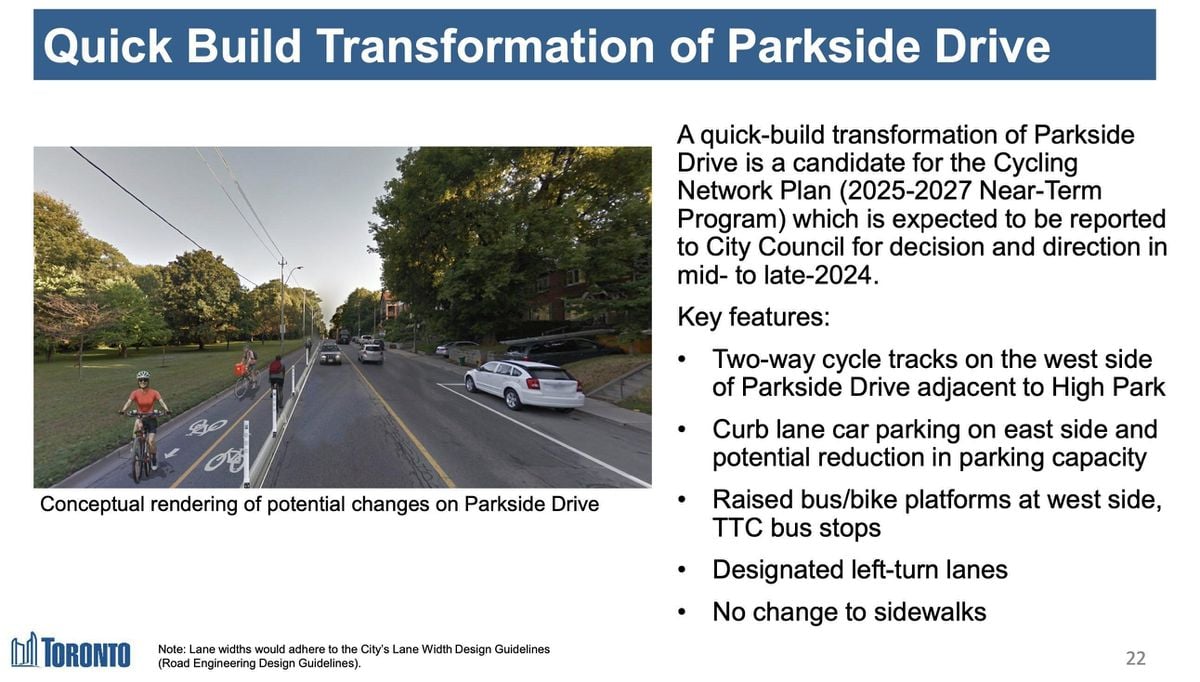Infra
Toronto’s Parkside Drive Plans Face Provincial Pushback

Residents of Toronto’s Parkside Drive are at the center of significant discussions as the city proposes the installation of bike lanes on this busy arterial road, known for its dangerous conditions. This announcement coincided with the Ontario government’s new legislative measures, which could impact the future of municipal bike lane installations across the province.
The proposal, articulated by city staff, entails the construction of a 1.9-kilometre, two-way cycling track along the west side of Parkside Drive, stretching from Bloor Street W. to Lake Shore Boulevard W. This initiative is part of broader design changes aimed at enhancing the safety of various road users, particularly vulnerable groups such as pedestrians and cyclists.
According to city reports, Parkside Drive has earned the reputation of being perilous, recording 1,487 collisions over the past decade, leading to five serious injuries and three fatalities among local residents and road users. “We’ve been waiting forever for this day to come,” said Faraz Gholizadeh, co-chair of the community advocacy group Safe Parkside. “We want to feel safe walking on our own street. The street, as it’s currently laid out, is not safe for pedestrians, not safe for cyclists, and not safe for motorists.”
The redesign proposal suggests reducing vehicle lanes from three to two across much of the road’s length, which city officials estimate could add one to three minutes to travel times during peak hours, with morning southbound commutes being most affected. This change has sparked debate among both city councilors and community advocates who prioritize safety over speed.
Local Councillor Gord Perks has expressed strong support for the initiative, stating, “We have been working as a community for years to make this street safer. I would be appalled if the premier of Ontario decided it was more important to save some commute time than to save lives. This will be a life-saving intervention.” This comment directly addresses the potential conflict with the provincial government’s newly introduced legislation, which will require municipalities to seek provincial approval before implementing new bike lanes if they involve the elimination of vehicle lanes.
The provincial government, led by Premier Doug Ford, has voiced concerns over such modifications, with Transportation Minister Prabmeet Sarkaria asserting their belief in pursuing a “common sense approach” to bike lanes. He underscored, “We do not support removing lanes of traffic on the most congested roads like Parkside Drive,” indicating potential pushback against the city’s safety-centric model.
The impetus for these proposed changes emerged after years of complaints from local residents, exacerbated by tragic incidents such as the deaths of an older couple struck by a speeding driver, which reignited community calls for improved safety measures. This tragic event happened just weeks after the city initiated a study of Parkside Drive back in late 2021.
The Parkside Drive Study aims to address longstanding issues such as narrow and missing sidewalks, high vehicle speeds, and aggressive driving behaviors. Besides adding bike lanes, the proposals include constructing designated turn lanes, new Toronto Transit Commission (TTC) bus stops, and reconstructing intersections to improve safety.
The proposed bike lanes would be separated from vehicle traffic by painted buffers and, where feasible, physical barriers. The estimated cost for implementing the suggested project is pegged at $7.5 million, with work projected to commence as early as 2026.
There’s frustration from residents like Gholizadeh about the long timeline, stressing, “There are residents who have been advocating for safety for two decades and are still waiting. It shows how slowly the city is moving to make our streets safe, aligning with our Vision Zero goals to eliminate serious injuries and fatalities on our roads.”
Toronto’s mayor, Olivia Chow, has indicated her opposition to the provincial limitations on municipal powers concerning bike lane implementations, reiteratively emphasizing, “It’s always beneficial to work together to improve safety. All modes of transportation are important, and we need to make them safe to prevent unnecessary deaths.” Chow’s remarks center around the recently adopted Vision Zero strategy, which aims for zero fatalities or serious injuries on city streets.
The city council’s infrastructure committee is set to deliberate on the recommendations at their upcoming meeting on October 22. Should the committee agree to move forward, detailed design work will ensue, with the proposal eventually progressing to the full council for final approval.
Many residents are watching closely as the bike lane project stands at the intersection of city initiative and provincial constraints. The proposal is not just about bike lanes; it’s about transforming Parkside Drive from being notorious for perilous accidents to becoming a safer and more communal space for all users of the road.
This situation reflects the broader tensions between needing to expand cycling infrastructure and maintaining adequate vehicle access on Toronto’s increasingly congested streets. The dialogue around the Parkside Drive redesign could set the stage for how other city projects navigate similar challenges in the future.
Indeed, the proposed changes on Parkside Drive serve as both a reactive measure to past tragedies and part of the city’s vision of proactively addressing urban road safety. The stakes remain high as community members and city officials work to create safer, more accessible streets, making the need for collaboration more urgent than ever.






:max_bytes(150000):strip_icc():focal(749x0:751x2)/taylor-swift-toronto-tout-112324-a65a2f3173b044cba3f8a53be0450471.jpg)


